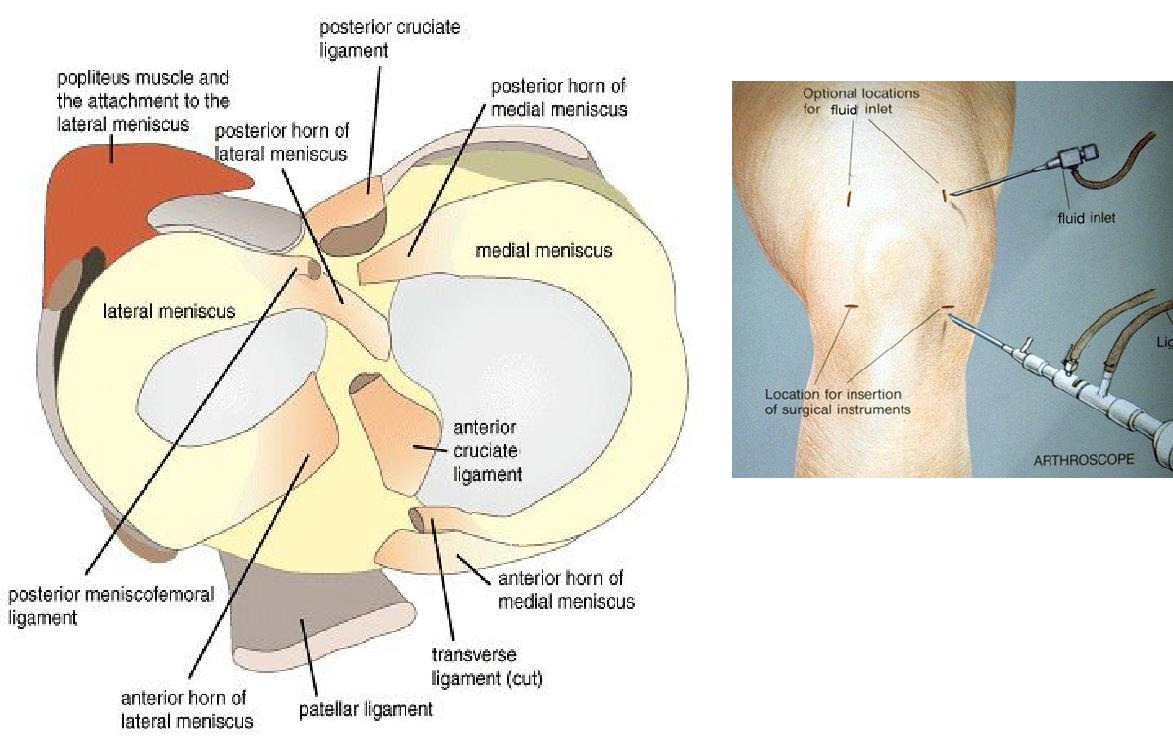ARTHROSCOPY of the knee is an operation in which a small camera and surgical instruments are inserted into your knee through two or three small (5mm) puncture wounds. The structures within the knee are assessed including the meniscus (mobile footballer’s cartilage), the synovium (lining of the knee), the articular cartilage (joint surfaces), and the cruciate ligaments (stabilizing structures).
The most common procedures performed include removing a torn portion of a meniscus, removal of a loose fragment within the knee which causes locking or catching of the joint, tidying up of worn areas of the joint articulating surface, and release of fibrous bands which can cause restriction of movement of the joint.
Surgery is performed under a general anaesthetic and the procedure takes between 20 – 40 minutes depending on what needs to be done. Surgery is usually performed as a Day Case procedure so that you will usually be able to go home 2 – 4 hours after the operation. Sometimes, for medical reasons, you are required to stay overnight.

BEFORE THE OPERATIONWhen you are admitted to the hospital Dr Sterling will mark the particular leg. Any last minute questions can be answered. The nursing staff and physiotherapist may also visit you to explain the procedure. |
AFTER THE OPERATIONIt is important to start exercising your knee as soon as possible because the muscles can become weak quite quickly. After your operation you will have a padded bandage around your knee. You cannot do any harm to your knee by lifting the leg straight, or by bending it, within the confines of the bandage. You can usually take full weight through the knee and you should try and walk as normally as possible. The exercises given to you by the physiotherapist can be started immediately. Start with a few and progress to approximately fifteen of each gradually over the next two weeks. AT HOMEThe bandage can be removed on the morning 2days following surgery. The puncture wounds will have a stitch or a steristrip tape keeping the wound edges together and will be covered by a small sticky dressing. Replace the dressing with an elastoplast dressing if necessary but keep the puncture wounds covered and keep the knee dry for five days to allow the puncture wounds to seal. WORKReturn to work when your knee feels comfortable and when you feel confident that your knee will be able to stand the stresses of your job. If you have an office type job you should be able to return to work after 1 week. If your job is strenuous and involves climbing and squatting then you will probably need two or three weeks off. PLEASE REMEMBER TO ASK FOR A CERTIFICATE IF YOU NEED ONE. DRIVINGDriving is usually possible after five days when the knee is feeling comfortable. Make sure you can bend and straighten your knee vigorously without pain. Check that you can perform an emergency stop safely. SPORTStrenuous physical activity and sport can be resumed when the knee is feeling strong and comfortable and is no longer swollen, which is usually after two to three weeks. This may depend on the type of surgery carried out. It is advisable to gradually increase your level of activity. Before returning to competitive sport such as football, squash or rugby, make sure you can hop, squat or sprint with changes of direction, and make sudden stops and starts – all without pain. IF YOU ARE CONCERNED:You may have moderate pain following the surgery and can take panadeine forte as provided or paracetamol The pain should lessen each day. You should contact Dr Sterling (through the switchboard of the hospital where you had your surgery), or his secretary on 1300478375. Whilst it is unlikely, if you feel extremely unwell, or there is an unexpected delay in finding Dr Sterling, attend the nearest Hospital Emergency Department. |
KNEE EXERCISES
These exercises should be started as soon as you have regained muscle control of your knee. They will be shown to you by the physiotherapist when you are in hospital
The exercises are designed to help you regain full range of movement and muscle strength in your leg. It is equally important to be able to bend your leg fully as it is to get it fully straight, and particularly to be able to lock the knee straight.
Build up the repetitions of each exercise gradually and aim for two 10 minute sessions per day.
- Static Quads Exercise: Sit on the bed/floor with your leg straight out in front. Use your thigh muscles to press the back of your knee into the bed/floor as hard as you can. Keep your toes pulled up towards your body. Hold for 5 seconds relax completely and repeat.
- Quads Exercise over a towel: Place a rolled up towel under your knee to a height of 6 inches. Pull your toes towards your body, tighten the thigh muscles and lift the foot off the floor until the knee locks straight. Do not lift the back of the knee off the roll. Hold for 5 seconds, lower slowly. Relax completely and repeat.
- Knee Bending on the bed: Practice bending your knee by sliding your heel towards your bottom. When the knee bends to a right angle progress to the next exercise.
- Knee bending over the edge of the bed: Sit over the edge of the table with your legs hanging down. Straighten your knee slowly.Hold for 5 seconds and lower gradually. Repeat.
- Knee bending while standing: Stand with hands on a table to support you. Bend your knee pulling your heel towards your bottom, then lower slowly back to floor. Relax completely and repeat.
